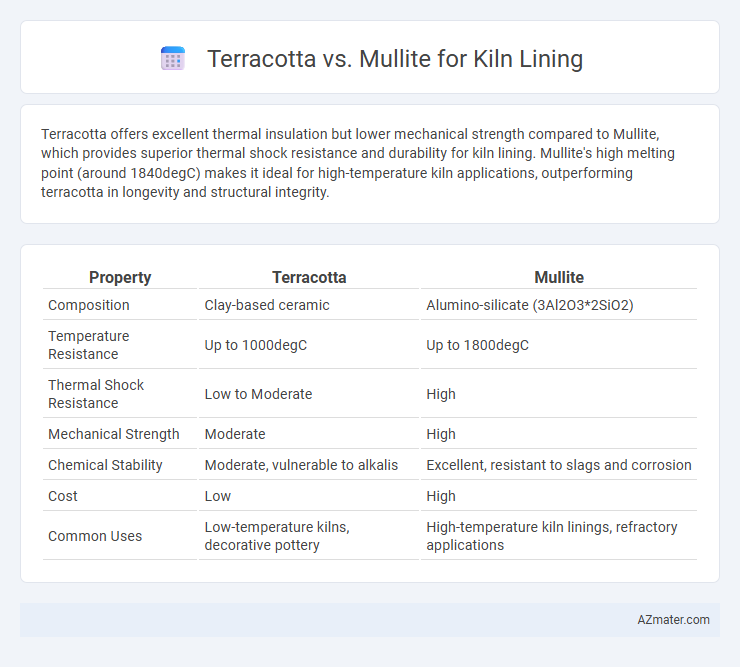Terracotta offers excellent thermal insulation but lower mechanical strength compared to Mullite, which provides superior thermal shock resistance and durability for kiln lining. Mullite's high melting point (around 1840degC) makes it ideal for high-temperature kiln applications, outperforming terracotta in longevity and structural integrity.
Table of Comparison
| Property | Terracotta | Mullite |
|---|---|---|
| Composition | Clay-based ceramic | Alumino-silicate (3Al2O3*2SiO2) |
| Temperature Resistance | Up to 1000degC | Up to 1800degC |
| Thermal Shock Resistance | Low to Moderate | High |
| Mechanical Strength | Moderate | High |
| Chemical Stability | Moderate, vulnerable to alkalis | Excellent, resistant to slags and corrosion |
| Cost | Low | High |
| Common Uses | Low-temperature kilns, decorative pottery | High-temperature kiln linings, refractory applications |
Introduction to Kiln Lining Materials
Kiln lining materials primarily include terracotta and mullite, each offering distinct thermal and mechanical properties suited for high-temperature applications. Terracotta is valued for its natural porous structure and affordability, while mullite, an alumino-silicate ceramic, provides superior thermal stability and resistance to chemical corrosion. Selecting the appropriate kiln lining depends on factors such as operating temperature, thermal shock resistance, and longevity requirements.
Overview of Terracotta as a Kiln Lining
Terracotta, a porous and heat-resistant clay material, is widely used for kiln lining due to its excellent thermal insulation properties and affordability. It offers moderate thermal shock resistance, making it suitable for low to medium temperature kilns, typically up to 1200degC. Its ease of shaping and relatively low density provides efficient heat retention while maintaining structural stability within ceramic and pottery kilns.
Properties of Mullite for Kiln Applications
Mullite exhibits exceptional thermal stability and low thermal expansion, making it ideal for kiln lining in high-temperature applications. Its high mechanical strength and excellent resistance to thermal shock ensure durability and longevity under rapid heating and cooling cycles. Mullite's superior corrosion resistance against molten slags and alkalis further enhances kiln performance and operational efficiency.
Thermal Resistance: Terracotta vs Mullite
Mullite exhibits superior thermal resistance compared to terracotta, with a melting point above 1840degC, making it ideal for high-temperature kiln linings. Terracotta, with a lower thermal resistance around 1000degC to 1200degC, is suitable for moderate heat applications but deforms under intense thermal stress. Choosing mullite enhances kiln durability and efficiency in environments requiring sustained high heat exposure.
Mechanical Strength Comparison
Terracotta exhibits lower mechanical strength compared to mullite, making it less resistant to high thermal and mechanical stresses in kiln lining applications. Mullite offers superior structural integrity and enhanced resistance to thermal shock, allowing for longer service life under extreme firing conditions. Its higher modulus of rupture and abrasion resistance make mullite the preferred material for durable and reliable kiln linings.
Chemical Stability in High-Temperature Environments
Terracotta and mullite exhibit distinct chemical stability profiles in high-temperature environments, with mullite offering superior resistance to thermal shock and chemical corrosion due to its alumino-silicate composition. Mullite maintains structural integrity above 1500degC, minimizing reactions with slag and fluxes common in kiln atmospheres, whereas terracotta, primarily composed of clay and iron oxides, tends to degrade and lose strength at elevated temperatures. The enhanced chemical inertness and refractory properties of mullite make it a preferred choice for industrial kiln linings subjected to aggressive thermal and chemical conditions.
Cost and Availability of Terracotta and Mullite
Terracotta offers an economical choice for kiln lining due to its widespread availability and lower raw material costs compared to mullite, which is often more expensive because of its higher purity and specialized manufacturing processes. Mullite, though pricier, provides superior thermal stability and mechanical strength, making it indispensable for high-temperature industrial applications where durability is critical. The cost-effectiveness of terracotta suits kilns with moderate temperature requirements, while the limited market availability and premium price of mullite restrict its use to advanced ceramic and metallurgy industries.
Lifespan and Durability in Kiln Use
Terracotta kiln linings offer moderate durability with a typical lifespan of 5 to 10 years under consistent kiln use, making them suitable for low to medium temperature firing. Mullite, composed primarily of aluminum silicate, provides superior thermal stability and resistance to thermal shock, resulting in a significantly longer lifespan of 15 to 25 years or more in high-temperature kiln operations. The enhanced durability and chemical inertness of mullite make it the preferred choice for industrial and frequent high-temperature firings where extended kiln lining life is critical.
Suitability for Different Types of Kilns
Terracotta is ideal for low-temperature kilns, such as pottery and ceramic kilns, due to its good thermal insulation and cost-effectiveness, but it lacks the high-temperature resistance required for industrial applications. Mullite excels in high-temperature environments, making it suitable for gas-fired or electric kilns used in advanced ceramics and metal processing, as it offers superior thermal shock resistance and structural stability. Choosing between terracotta and mullite depends on the kiln's operating temperature and the specific thermal requirements of the firing process.
Conclusion: Choosing the Best Lining Material
Terracotta provides excellent thermal insulation and cost-effectiveness, making it suitable for low to medium temperature kiln applications, while mullite offers superior thermal stability, resistance to thermal shock, and durability at high temperatures above 1500degC, ideal for industrial or long-duration firings. Mullite's higher refractoriness and mechanical strength make it the preferred choice for advanced ceramic production and continuous kiln operations. Selecting the best lining material depends on specific firing temperature requirements, operational frequency, and budget considerations, with mullite favored for high-performance needs and terracotta for economical and moderate temperature use.

Infographic: Terracotta vs Mullite for Kiln Lining
 azmater.com
azmater.com